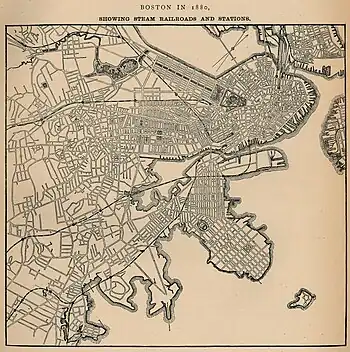


Fort Point Channel is a maritime channel separating South Boston from downtown Boston, Massachusetts, feeding into Boston Harbor. The south part of it has been gradually filled in for use by the South Bay rail yard and several highways (specifically the Central Artery and the Southeast Expressway). At its south end, the channel once widened into South Bay, from which the Roxbury Canal continued southwest where the Massachusetts Avenue Connector is now. The Boston Tea Party occurred at its northern end. The channel is surrounded by the Fort Point neighborhood, which is also named after the same colonial-era fort.
The banks of the channel are still busy with activity. South of Summer Street on the west side of the channel is a large United States Postal Service facility. A large parcel, home to Gillette, lies at the southeast corner of the channel. The back of the Federal Reserve Bank of Boston building looks over the channel, and another federal building, the John Joseph Moakley United States Courthouse, lies on Fan Pier at the mouth of the channel. One of Boston's odder attractions, the Hood Milk Bottle, lies on the banks as well, next to Boston Children's Museum. During the 1980s, a nightclub and popular concert venue called The Channel was located on the South Boston bank.
On October 21, 2011, Fort Point Pier opened for public use south of the Summer Street Bridge. To prepare for construction, a fifty-foot (15 m) section of the Fort Point Channel seawall south of Necco Court was restored by P&G Gillette. Public access has made Fort Point Channel popular for kayaking and standup paddle boarding.
The chief engineer of the Boston Water and Sewer Commission has proposed a stormwater barrier as part of the replacement for the now-closed Northern Avenue Bridge. Fort Port Channel drains a large portion of Downtown Boston, South Boston, and Dorchester.[1][2]
Crossings


The following bridges and tunnels cross or used to cross the channel, from north to south, with building/opening dates:
- Northern Avenue Bridge (built 1908, closed to vehicles in 1997, closed to pedestrians in 2014)
- Evelyn Moakley Bridge (1996, New Northern Avenue/Seaport Boulevard)
- Silver Line tunnel, 2004
- Congress Street Bridge, 1930 (replaced an 1874-built swing bridge at same location)[3]
- Summer Street Bridge, 1899
- Previously at this location: New York and New England Railroad (shifted to Boston and Providence terminal in Park Square during construction of South Station which opened in 1899)
- Mount Washington Avenue Bridge (gone, Mount Washington Ave now enters the Gillette plant)
- Fort Point Channel tunnel (1994, I-90)
- Dorchester Avenue Bridge, 1925 (formerly Federal Street Bridge)
- Atlantic Avenue Viaduct (1899-1923)
- MBTA Commuter Rail bridge, fixed span constructed in 1988, serving the Old Colony Lines and Fairmount Line. Previously at this location:[4]
- Six-track, three span Rolling Lift Bridge constructed 1898-1900 to provide combined connection to the new South Station for the Old Colony Railroad and New York and New England Railroad (via Fairmount). By the time of completion, these railroads had merged into the New York, New Haven and Hartford Railroad. Remnants memorialized in Rolling Bridge Park, at the same location.
- Original bridge for the Old Colony Railroad, demolished in 1910 (on the site of the 1988 bridge).
- Red Line tunnel, 1917 (roughly underneath the Commuter Rail bridge)
- Broadway Bridge (relocated, new bridge opened January 19, 1999)
The channel now ends here; the remaining bridges cross the South Bay Yard or Fairmount Line.
- West Fourth Street Bridge, 1958 (formerly Dover Street, with an older bridge)
- South Boston Bypass Road (opened in 1993 as part of the Big Dig going east from I-93; follows depressed NY&NE corridor, now Track 61[5])
- New York and New England Railroad on a long diagonal bridge, now used by the MBTA Commuter Rail and trains to the South Boston Freight Terminal - this bridge passed under the next two
- Southampton Street (formerly Swett Street)
- Massachusetts Avenue (formerly East Chester Park)
See also
References
- ↑ Fort Point Channel floodgate idea advances, but how to pay for it?
- ↑ BWSC and Hazen (November 2022). "Fort Point Channel Storm Surge Barrier" (PDF).
- ↑ Historic American Engineering Record (HAER) No. MA-38, "Congress Street Bascule Bridge"
- ↑ John Sheridan (November 11, 2011). "The Rolling Lift Bridge".
- ↑ Frank S. DeMasi (November 2009). "Intermodal Corridor To the Port of Boston: The South Boston Haul Road – RAIL CORRIDOR".